Full Moon at Mid-Summer Won’t Worry Bright Evening Planets, the Moon Points to Mars in Daytime, Ceres Tickles the Toes of Aquarius, and NEOWISE near Globulars!
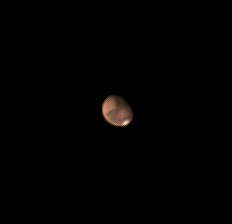
This image of Mars, captured using a camera affixed to his 8″ SCT telescope, was taken by my friend Claudio Oriani at his home in Richmond Hill on July 28, 2020. It features some Mars’ most prominent features, such as Hellas (bright area to the left), Syrtis Major (dark area) and the southern polar cap (white). This is just the beginning of several months to come with fantastic views of Mars.
Hello, Mid-Summer Stargazers!
Here are your Astronomy Skylights for the week of August 2nd, 2020 by Chris Vaughan. Feel free to pass this along to your friends and send me your comments, questions, and suggested topics. You can also follow me on Twitter as @astrogeoguy! Unless otherwise noted, all times are expressed in Eastern Time.
I can bring my Digital Starlab portable inflatable planetarium to your school or other daytime or evening event, or teach a session online. Contact me through AstroGeo.ca, and we’ll tour the Universe, or the Earth’s interior, together!
Three bright planets for evening observers! Dim comet NEOWISE will fly past two globular clusters. We get off-peak meteors from two showers. The full moon will shine brightly on Monday, and then wane through the week. When it visits Mars next Sunday, you can use it to see Mars in daytime! Minor planet Vesta passes Mercury, and Ceres tickles Aquarius’ toes. Here are your Skylights!
Mid-Summer
Wednesday, August 5 at 1:08 pm EDT will mark the mid-point of summer in 2020 – falling halfway between the June Solstice and the September Equinox. It is one of the four so-called cross-quarter days, which are the season midpoints following each solstice and equinox. Many pagan groups schedule Lammas or Lughasadh festivals around this time (mostly on Saturday, August 1 in 2020) – to celebrate the early harvest. The term “lammas” refers to grain or bread. (Tolkien readers will notice that it resembles the word “lembas”, the Elven Waybread, from the same root.) The next cross-quarter day will occur in three months, at the beginning of November. That’s Samhain – but we celebrate it on the evening before – as Halloween!
Meteor Showers
The bright moon this week will put a damper on the two meteor showers that are under way – but you’re still likely to spot a few “shooting stars” on any clear night. Last week’s Southern Delta Aquariids meteor shower, caused by the Earth passing through a cloud of tiny particles dropped by a periodic Comet 96P/Machholtz, will taper off until August 23. The meteors will appear to travel away from from the shower’s radiant, in Aquarius (the Water-Bearer), which sits in low in the southeastern sky during evening.
The spectacular Perseids Meteor Shower, which is produced from debris dropped by Comet Swift-Tuttle, will be ramping up this week. At its peak next Tuesday, August 11, we could see up to 100 meteors per hour. True Perseids will appear to be travelling away from the constellation of Perseus (the Hero), which sits low in the northeastern sky in evening.
I’ll share some meteor-watching tips next week.
Comet NEOWISE close to Messier 53
In the western sky after dusk on Thursday, August 6, the path of fading Comet C/2020 F3 (NEOWISE) will carry it closely past the globular star clusters named Messier 53 and NGC 5053. Find the trio a finger’s width above (or 1 degree to the celestial northeast of) the medium-bright star Diadem, also known as Alpha Comae Berenices. The comet, the star, and the two clusters will all appear together within the field of view of a telescope at low magnification, offering a nice photo opportunity. The bright moon will make this meeting a challenge to see – but a long exposure photograph should capture them.
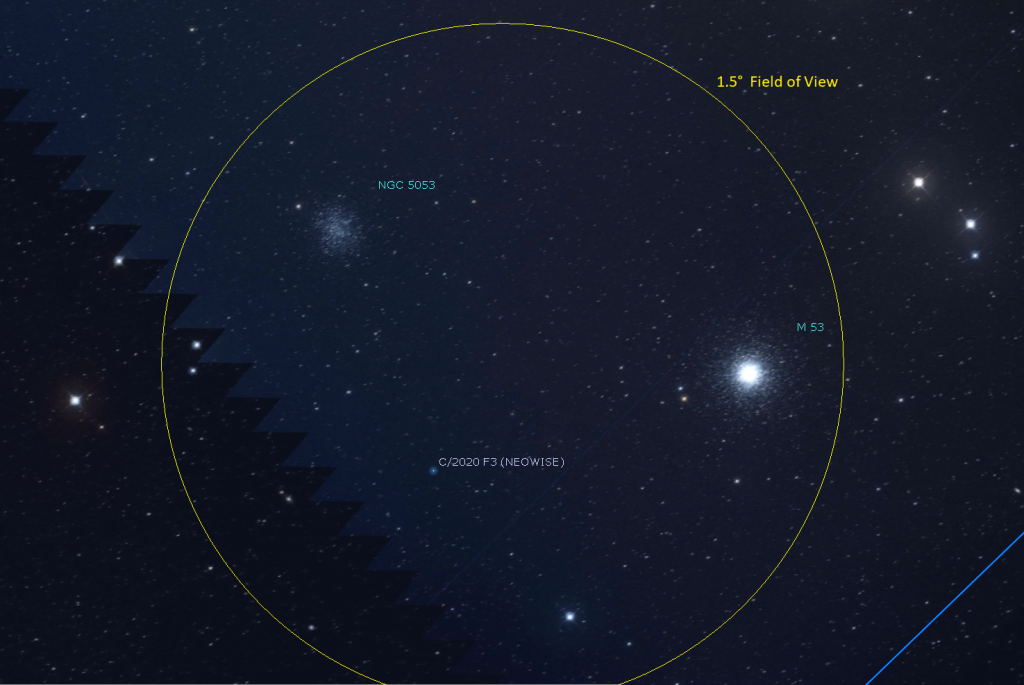
The Moon
The moon will dominate evening skies around the world for the first part of this week. Tonight (Sunday), the nearly-full moon will rise in the southeast before sunset, and then shine brightly all night long – forming a rough line with modest Saturn and bright Jupiter, which will be arrayed to the moon’s right (or west).
On Monday at 11:59 am Eastern Time (or 15:59 Greenwhich Mean Time), the moon will officially reach its full moon phase. The August full moon, colloquially called the “Sturgeon Moon”, “Black Cherries Moon”, and “Green Corn Moon”, always shines among or near the stars of Aquarius or Capricornus. The indigenous Anishinaabe people of the Great Lakes region call this moon Manoominike-giizis, the Wild Rice Moon, or Miine Giizis, the Blueberry Moon. The Cree Nation of central Canada calls the August full moon Ohpahowipîsim, the Flying Up Moon. The Haudenosaunee (Iroquois) of Eastern North America call it Seskéha, the Freshness Moon.
Full moons are always opposite the sun in the sky, causing them to rise at sunset and set at sunrise. Since the full phase will officially occur around mid-day Monday in the Americas, the moon will appear to be full on Sunday night, too. But magnified views will reveal a thin strip of darkness along the moon’s western and eastern limbs on Sunday and Monday night, respectively. Observers living at Middle Eastern longitudes will see the moon rising while it’s precisely full.
At this time of year, the moon’s orbit makes a shallow angle with the eastern horizon in evening. From one evening to the next, the moon’s orbital motion carries it more right-to left than up-to-down, causing the moon to rise at almost the same time. The effect is most pronounced when the moon is full close to the September Equinox. We call that one the Harvest Moon.
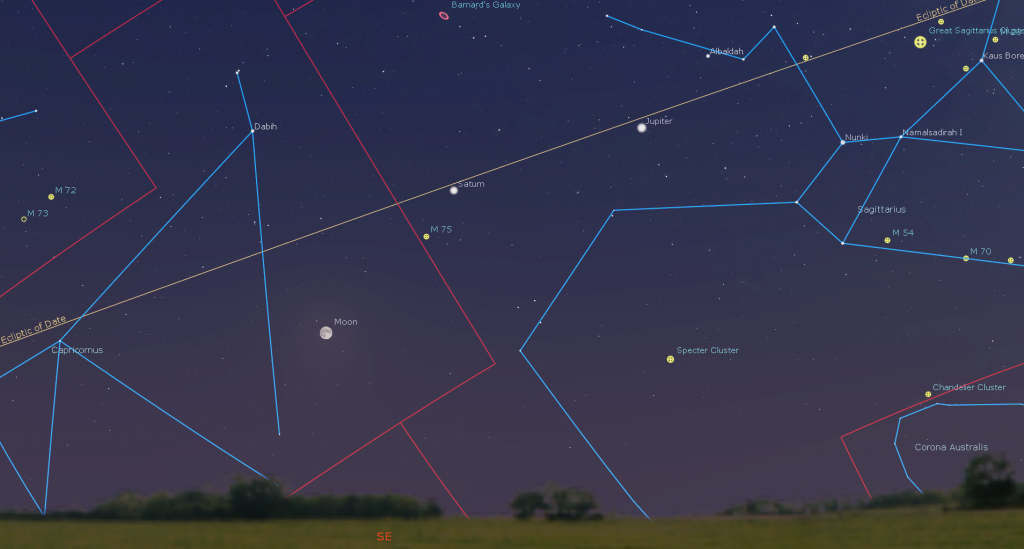
After Monday, the moon will wane in phase and rise later. It will traverse the dim stars of Aquarius (the Water-Bearer) from Tuesday to Thursday. On Friday and Saturday night, the moon will skim through the top of Cetus (the Whale).

When the waning gibbous moon rises in the east shortly before midnight on Saturday, August 8, it will be positioned only two finger widths to the lower right (or 2.3 degrees to the celestial southwest of) bright, reddish Mars! The moon and Mars, which will fit nicely together in the field of binoculars, will cross the night sky together. During that period, the moon’s eastward orbital motion will carry it closer to Mars, and the diurnal rotation of the sky (i.e., due to the Earth rotating) will shift Mars to the moon’s upper right.
They will not set in the west until mid-morning on Sunday – offering a chance to see Mars in the morning daytime sky using binoculars and backyard telescopes, by using the moon as a reference. Try to look for Mars before they drop too low in the sky – say before 9 am local time. (Take extreme care to avoid pointing telescopes or binoculars anywhere near the sun! Parental supervision is a must!) Observers in most of western Antarctica, southeastern South America, and the Ascension Islands will see the moon pas in front of (or occult) Mars around 08:00 GMT on August 9.
The Planets
Jupiter and Saturn – and later, Mars, will all be shining brightly in the evening sky this week, whether or not the moon is there to point the way to them. They’re available for everyone around the world to enjoy after dusk.
Yellow-tinted Saturn is chasing brighter, whiter Jupiter across the night sky this summer – lagging it by only a generous palm’s width. Soon after dusk in, low the southern sky, both planets will be visible to unaided eyes. They’re among the stars of eastern Sagittarius (the Archer). That constellation, with its obvious teapot-shape, is centred only a fist’s width to the right of Jupiter. Saturn is a spectacular sight in backyard telescopes. Its rings, which will be narrowing every year until the spring of 2025, will span 43 arc-seconds. (That’s about the same as Jupiter’s disk). See if you can see the narrow, dark gap that separates Saturn’s inner ring from its outer one. Called the Cassini Division, it’s one of many spaces in the rings!
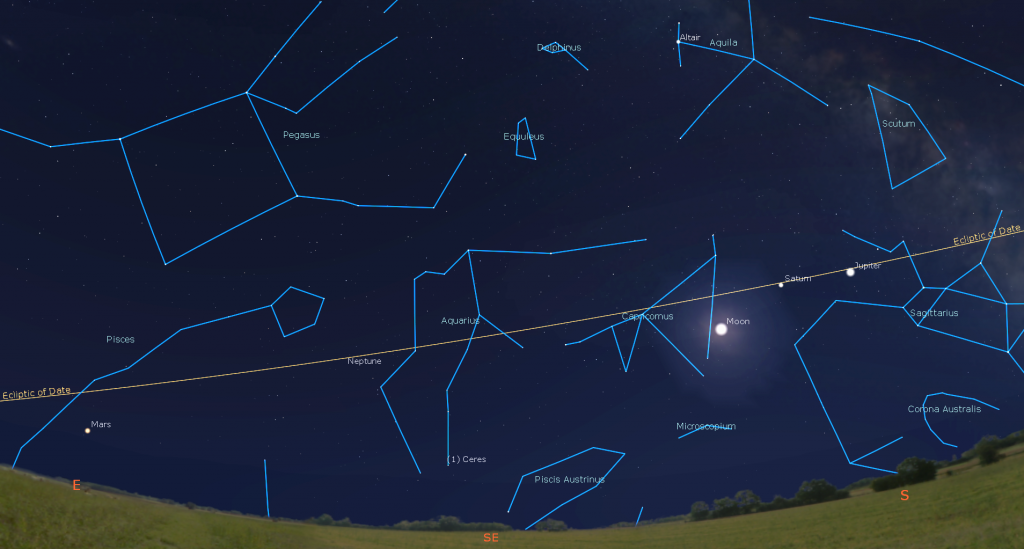
Even a small telescope will show Saturn’s rings and several of its brighter moons – especially its largest moon, Titan! Because Saturn’s axis of rotation is tipped about 27° from vertical (a bit more than Earth’s axis), we can see the top surface of its rings, and its moons can arrange themselves above, below, or to either side of the planet. During this week in late evening, Titan will migrate counter-clockwise around Saturn, moving from the lower left of Saturn tonight (Sunday) to the right of the planet next Sunday. (Remember that your telescope will flip the view around.)
Very bright Jupiter will appear first after dusk. Good binoculars will reveal Jupiter’s four large Galilean moons named Io, Europa, Ganymede, and Callisto as they dance around the planet from night to night. Even a modest-sized telescope will show Jupiter’s brown equatorial belts and the famous Great Red Spot (or GRS, for short) if the air is steady. Due to Jupiter’s 10-hour period of rotation, the GRS appears every second or third night from a given location on Earth. In the Eastern Time zone, the Great Red Spot will be crossing the planet’s disk after dusk on Wednesday, and Friday. It will also appear starting in late evening tonight (Sunday), Tuesday, and next Sunday, and before dawn on Wednesday, Friday, and next Sunday.
From time to time, the round, black shadows cast onto Jupiter by its Galilean moons are visible in amateur telescopes as they cross (or transit) the planet’s disk for a few hours. On Friday, Io’s shadow will cross Jupiter from 10:13 am to 12:30 am EDT.
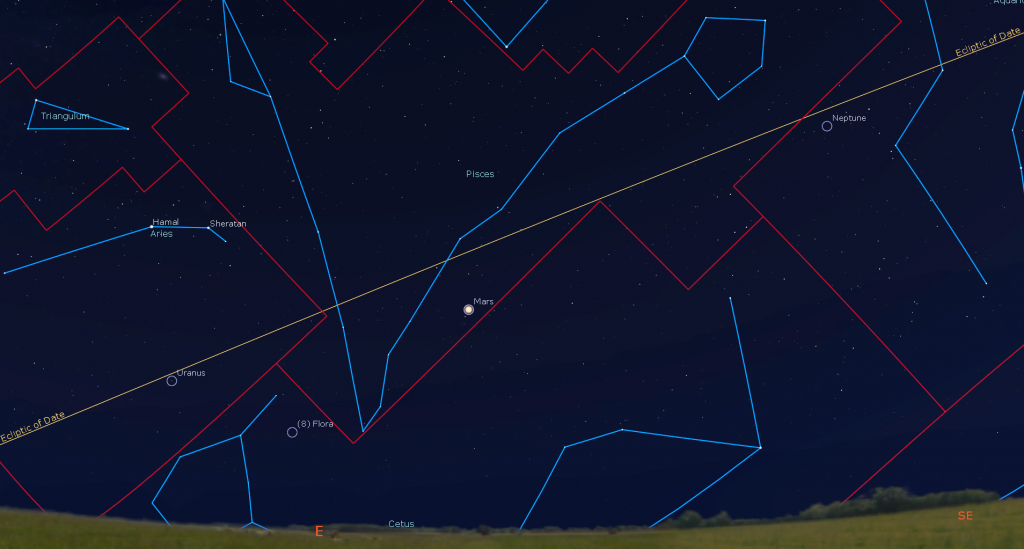
Excitement is already building for Mars, which will put on a great sky show this autumn! Mars is steadily increasing in disk size and brightness because Earth is travelling towards it this summer. This week, the Red Planet will be rising in the east at about 11:30 pm local time. It’s just to the right (or celestial west) of the V-shaped, faint constellation of Pisces (the Fishes), and above Cetus (the Whale). Mars will be visible as a prominent, reddish dot in the lower part of the sky until dawn, when it will be positioned about five fist diameters above the southern horizon. (Don’t forget to use the moon to spot Mars in daytime next Sunday morning!)
Dim and distant Neptune is located about three fist diameters to the right (or 30° to the celestial west) of Mars, among the stars of eastern Aquarius (the Water-Bearer). Neptune rises at about 10 pm local time and then climbs higher until about 4 am local time, when you’ll get your clearest view of it, halfway up the southern sky. Neptune is hard to find without a computerized telescope. The nearest medium-bright star is Hydor, which is located a slim fist’s diameter to the planet’s right. Wait until next week’s moonless sky to search for it.
Blue-green Uranus will rise shortly before midnight local time this week. Normally, it’s visible with unaided eyes and in binoculars under a dark sky – but this week’s bright moon will make seeing it without a telescope tougher. Look for the magnitude 5.8 ice giant planet sitting in southern Aries (the Ram) – about a fist’s diameter below the ram’s brightest stars Hamal and Sheratan.
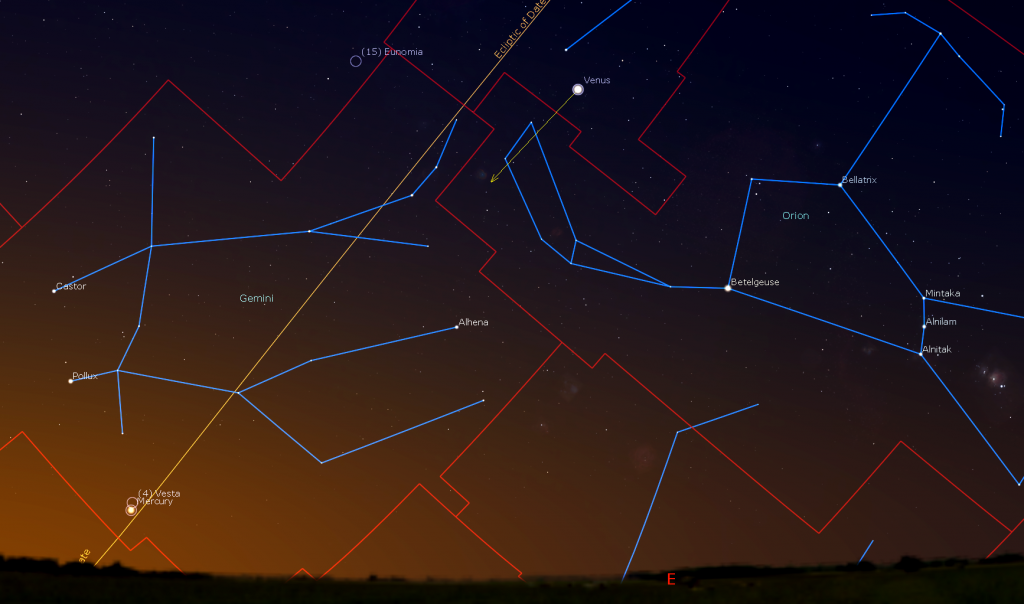
Early risers can’t miss extremely bright Venus, which will rise in the east at about 2:45 am local time this week, and then remain visible until sunrise as it climbs the sky. Viewed in a backyard telescope, Venus will show a half-illuminated shape. The bright, orange-tinted star sitting a generous fist’s diameter to Venus’ lower right (or 13° to the celestial south) is Betelgeuse, in Orion (the Hunter)! I’ve heard that Betelgeuse has still not brightened to its normal intensity after last December’s dramatic dimming. The almost-twin stars Castor (higher) and Pollux (lower) in Gemini (the Twins) will sit a similar span to Venus’ lower left this week. Venus’ orbital motion is carrying it downward between Orion and Gemini.

Speedy little Mercury will drop a little lower every morning as it descends sunward. Try looking for the planet sitting very low in the east-northeastern sky at about 5:15 a.m. in your local time zone. On Monday and Tuesday morning, the main belt asteroid Vesta will pass close to Mercury. On Monday, it will be sitting just a pinky finger’s width above (or 22 arc-minutes to the celestial northwest of) Mercury, and just to Mercury’s left on Tuesday – but the approaching dawn will make seeing the magnitude 8.1 asteroid tough unless you live near the equator, where the sky will be darker when they rise.

You’ll have an easier time seeing the dwarf planet (formerly asteroid) Ceres. On the nights surrounding Wednesday, the magnitude 8 object will pass by the medium-bright star c2 Aquarii or 88 Aquarii, which marks the western foot of the Water-Bearer. The star and Ceres will fit into the field of view of a backyard telescope at medium magnification from now until next Saturday – with Ceres moving steadily to the right (or towards celestial southwest) compared to that star. At closest approach on Wednesday, Ceres will sit just 10 arc-minutes (or one-third of the moon’s diameter) below 88 Aquarii. Remember that your telescope will likely flip the view around.

Public Astro-Themed Events
Every Monday evening, York University’s Allan I. Carswell Observatory runs an online star party – broadcasting views from four telescopes/cameras, answering viewer questions, and taking requests! Details are here. Their in-person Wednesday night viewing has been converted to online via the observatory Youtube channel, where they offer free online viewing through their rooftop telescopes, including their new 1-metre telescope! Details are here.
This week, from Wednesday to Friday, noon to 4 pm EDT, Western University is running a virtual conference for Space Educators. They will have many wonderful presenters, including well-known Phil Plait and Bruce Betts – plus some local SciComm stars like my friends Dr. Bhairavi Shankar and Dr. Parshati Patel. It’s free, but registration is required. Details are here.
My Insider’s Guide to the Galaxy webcasts with Jenna Hinds of RASC National will continue on Tuesday, August 11 from 3:30 to 5 pm EDT. Details and the schedule are here. Beyond that, join Jenna and John Reid on alternate Thursdays at 3:30 pm EDT as they run through the RASC’s Explore the Universe certificate.
The Canadian organization Discover the Universe is offering astronomy broadcasts via their website here, and their YouTube channel here.
On many evenings, the University of Toronto’s Dunlap Institute is delivering live broadcasts. The streams can be watched live, or later on their YouTube channel here.
The Perimeter Institute in Waterloo, Ontario has a library of videos from their past public lectures. Their Lectures on Demand page is here.
Keep looking up, and enjoy the sky when you do. I love questions and requests. Send me some!